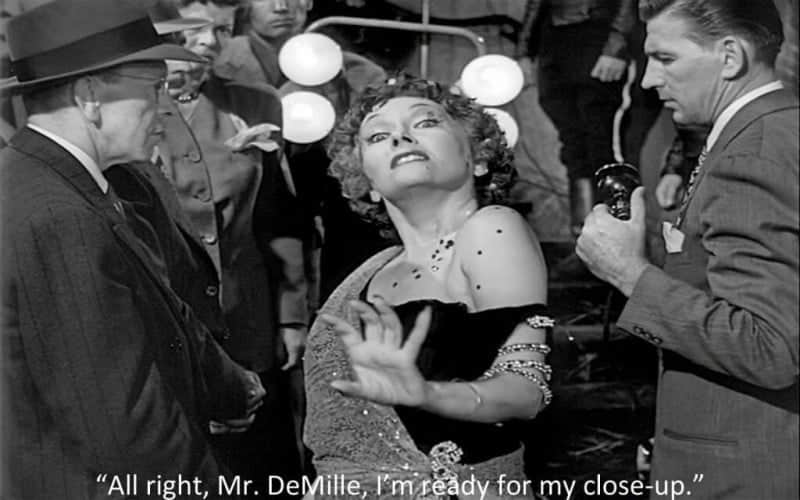
How To Write a Blog Bio to Look Smart
Do you know how to write a blog bio? Does your About Me on your blog need a makeover? My author bio certainly does. This post is my 100th blog post – a milestone! It’s time to learn how to write a bio that, well, reflects who I am. Alright, Mr. DeMille, I’m ready for my closeup.

Potentially, your ‘About Me‘ page could be seen by a vast audience that includes potential and existing employees, other professionals in your field, as well as friends/relatives.
Your author bio is an excellent way to show your audience who you are and why they should trust you, and subscribe to your future posts. It also serves as a means to succinctly define your expertise on why they should follow you.
It’s your opportunity to tell the world who you are and what you do, so don’t squander it.
How to Write a Blog Bio
The first thing to know: There is no “right” way to author your ‘About Me’ bio. Some read like resumes, and others read like fun stories.
Writing a professional bio can be a daunting task, but it doesn’t have to be. Crafting an effective bio requires conveying that you are credible and accomplished in a few sentences. It is important to identify the context of the professional bio before beginning the writing process.
Start by introducing yourself with your name and current job title or role. Then provide some background information about your education and work experience that is relevant to your current position. Also, include any awards or accomplishments that demonstrate your expertise in the field. And don’t forget to inject a dose of what makes you an interesting human.
Obviously, the tone of the bio depends on where it will appear.
- If you are writing a guest post targeting Mom’s in business, then you might mention kids or your experience with kids or being a Mom.
- On the other hand, if writing a bio for a trade journal or a speaking engagement, your focus might be on your years of experience, expertise, and education.
Here’s a snapshot of my 5-year-old “folksy” bio desperately needing a makeover:

No matter what the audience or the tone, there are a few things to remember that will make writing your bio easier.
Identify Your Audience!
The easiest way to do this is by having a good look at your current website or blog.
- What is its voice?
- Who is it targeting?
- What is the aim of the publication?
How to Write Your Blog Bio in 9 Easy Steps
Writing a blog bio is an important step in establishing your online presence. It helps readers get to know you and understand why they should trust your content. Crafting an effective “About Me” section can be tricky, but with the right approach, it can be done in 9 easy steps.
Step 1: Brainstorm
When crafting a blog bio, it’s important to put yourself in the reader’s shoes and write about what they would want to know. Focus on highlighting key questions they may have and how they can find answers on your blog. Remove any unnecessary information and keep the bio short, sweet, and to the point.
Step 2: Select Key Information to Include in Your Blog Bio
Writing a blog bio is an essential part of creating a successful website. It gives readers an impression of you and your content, and sets your blog apart from other options. Crafting a compelling blog bio is crucial to make a case for why people should stay on your website. To create an effective blog bio, it’s important to identify the purpose of writing it in the first place.
- When crafting your blog bio, don’t forget to utilize tips and tricks that will make it stand out from the rest. Use keywords that are relevant to your topic so that search engines can easily find your website.
- Include Highlight links to social media profiles or other websites where readers can learn more about you or connect with you directly. Finally, be sure to keep your credentials visible.
Step 3: Include Images and Your Contact Details
As the Head of Finance & Operations at dlvr.it, I have a wealth of experience in social media and digital marketing. My passion for helping businesses succeed has driven me to stay up-to-date on the latest trends and strategies. I’m always looking for ways to help companies maximize their online presence and reach their goals. This is the information I need to convey to the public in a compelling way.
The bio area of a blog is an important part of any website. It can be the deciding factor in whether or not they stay on your site. A well-crafted bio can help to keep readers engaged and on the site, as it gives them an impression of you and your content. It should be concise yet informative, giving readers a quick overview of who you are and why your website has the answers they’re seeking. Be brutal – just cherry-pick the most relevant, interesting stuff and ditch the rest, especially the fluff.
Your blog biography should be unique to you and your content. You have to make a case for what sets your blog apart from others in such a short space. This means that you need to include information about yourself, such as qualifications or experience, as well as details about what makes your blog special. Additionally, it’s important to include keywords related to the topics you write about so that search engines can easily find your website when people are looking for answers online.
Step 4: Highlight Unique Qualities
When writing a blog bio, it’s important to include keywords that will help search engines and potential readers find you. Take five minutes to make your blog better by updating the short bio in your site’s sidebar with relevant information about yourself and what you do. A strategically written bio should be concise yet descriptive, highlighting the unique qualities that make you stand out from the crowd.
Your bio should be tailored to your target audience so they can immediately recognize that they are in the right place when they land on your page. Even the most professional short bios should include something that shows you are a real person.
Your industry recognition can help prove your expertise in your chosen field. Google’s E-A-T ranking score (Expertise, Authoritativeness, Trustworthiness) is especially important for health, fitness, and finance blogs. You can draw attention to these credentials without a long list by displaying logos or images related to them.
You should also share popular blogs you’ve been published on, books you’ve written, and certifications you have. Showcasing the famous brands you’ve worked with and the big results you’ve got in the past will also help prove your authority.
However, listing awards, accomplishments, medals, blue ribbons, trophies, and honorary titles that make you look accomplished in your field can have an unwanted effect on your audience – they might not know what any of these awards actually mean. Can listing your accolades seem like “bragging”? Well, yes. The balance is finding the line between asserting your knowledge, while also writing in a language that they will understand.
Step 5: Give Yourself a Time Limit
Once your fingers hit the keyboard, and you start writing the bio, you should be able to write a short one within 30 minutes, and a longer one in an hour. A time limit will make you write from the heart, which is where the best bios live. Then put it aside for an hour or so before a final proofread and edit before sending. Don’t sit on it too long or it will never finish.
Step 6: Write in the First Person
There are two sides to this argument: When thinking about how to write a bio, should you write your bio in the first person or in the third person?
Unfortunately, there are downsides to both.
- If you write in the first person, you can’t really brag about yourself, because it can come across as conceited.
- If you write in the third person, that can get weird, too… especially if the rest of your blog or website is in the first person. Because then people know you’re bragging about yourself and that you just wanted to disguise the fact that you were doing it by pretending someone else wrote it.
So, what do you do? Ultimately, this comes down to personal preference and your audience. In my opinion, the first-person point of view is the most intimate way to write you bio.

Step 7: Include Contact Details
Well, duh, but in all the stress this is sometimes forgotten. And don’t forget any social media profiles.
Now for the unveiling. Here’s what I came up with by following these eight steps:
About Debra Garber
Head of Finance & Operations at dlvr.it. Slipped a writing sample under the CEO’s door and now, happily sharing my experiences traversing the wilds of social media. Backyard chicken farmer. Will trade social media tips for organic eggs.
Step 8: Get a Second Opinion.
Ask several people – colleagues, co-workers, family members, and friends – to review your author bio and provide feedback. After you receive the feedback, edit your bio as needed. Why ask friends? Because they’ll be honest with you.
Thankfully for me, my daughter and son-in-law, both writers, arrived just in time to open a bottle of wine, ask some great questions and slash away at my blog bio.
Version 3. We’ll go with this one for now:

Take a deep breath.
Unfortunately, you are not done!
LAST STEP (this may be the most important one): Include an Amazing Photo
Yes, investing in a good headshot is worth every penny.
Think about all the times you’ve read a great blog author bio and then squinted at the blurry, green-toned, unflattering image of the person it described. Doesn’t it kind of dampen your enthusiasm and admiration for them? NOT because of the way they look, but because they clearly didn’t make the effort.
The Quality of the Image Does Matter!
And, whether you like or not, people’s first impressions can be significantly affected by the quality of your photo.
Here’s a must read: The Anatomy of a Picture Perfect Profile Image on Social Media
After following this guide, I uploaded a much better image, and voila…

Summary – How To Write a Blog Bio to Look Smart
A blog bio is an essential part of any website or blog. It is the first thing readers will look at to decide if your content is right for them. Your blog bio should be short and concise, providing a jumping-off point for other social media platforms. It should give readers an idea of what your website has to offer and why they should stay on it. And, it needs to inform them why they should come back regularly to read from YOU.
Your blog bio is important because it tells readers why your website has the answers they’re seeking. It gives people an impression of you and your content and sets your blog apart from other options. Writing a compelling blog bio is crucial to make a case for why people should stay on your website and become subscribers, as well as clients or customers. A good blog bio will include information about yourself, what topics you cover, and how often you post new content. Additionally, it should provide links to other social media accounts so that readers can easily find more information about you and your work. And not only that, but make it fun, interesting, and engaging. That’s what will catch their eye, and keep them coming back.
Debra Garber
Related Posts
IN THIS ARTICLE


